This Sourdough Bolo do Caco, also known as Tile Bread, is a delightful twist on the traditional Madeiran bread. It is made with nutritious white sweet potatoes and incorporates a wholesome blend of rye flour and flax meal.
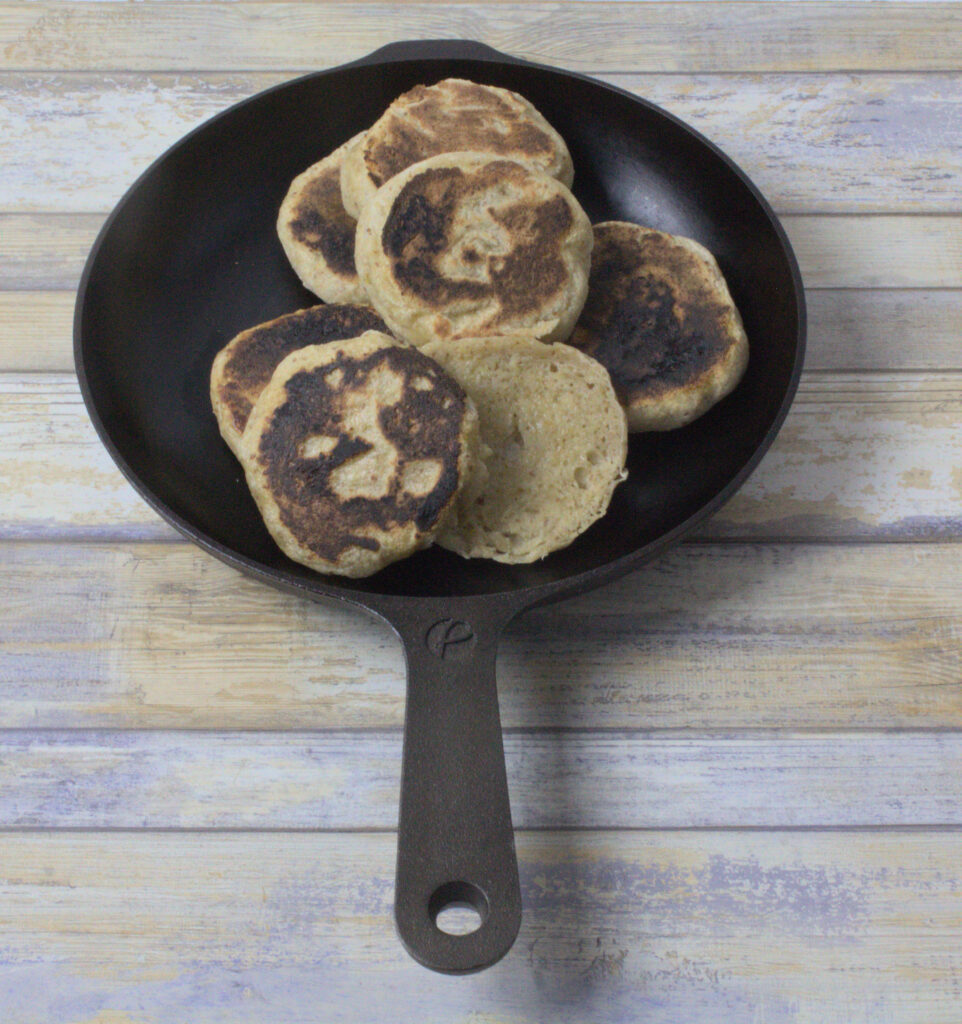
This bread is distinctive not only for its ingredients but also for its cooking method: it is traditionally baked on a flat basalt stone slab called a “caco,” which is where the name comes from.
Madeiran bread is typically served warm, and often as a side to meals or as a snack. It is frequently sliced open and buttered with garlic butter, sometimes including herbs like parsley. Bolo do caco is particularly popular as an accompaniment to espetadas (grilled meat skewers) and is a beloved part of Madeiran cuisine.
Bolo do Caco is the bread of the month for the Bread Baking Babes. Elizabeth, of blog from Our Kitchen, is the host kitchen this month. Elizabeth’s Bolo do Caco (Tile Bread) is based on recipes in SAVEUR Magazine No.74 (April 2004 Bolo do Caco, Karen’s Kitchen Stories’ Portuguese-Style Sweet Potato Rolls {Bolo do Caco}, and Cozinha Tradicional’s Bolo do Caco (Madeira). Links are provided in resources.
My naturally leavened version brings out a subtle tang that complements the inherent sweetness of the sweet potatoes.
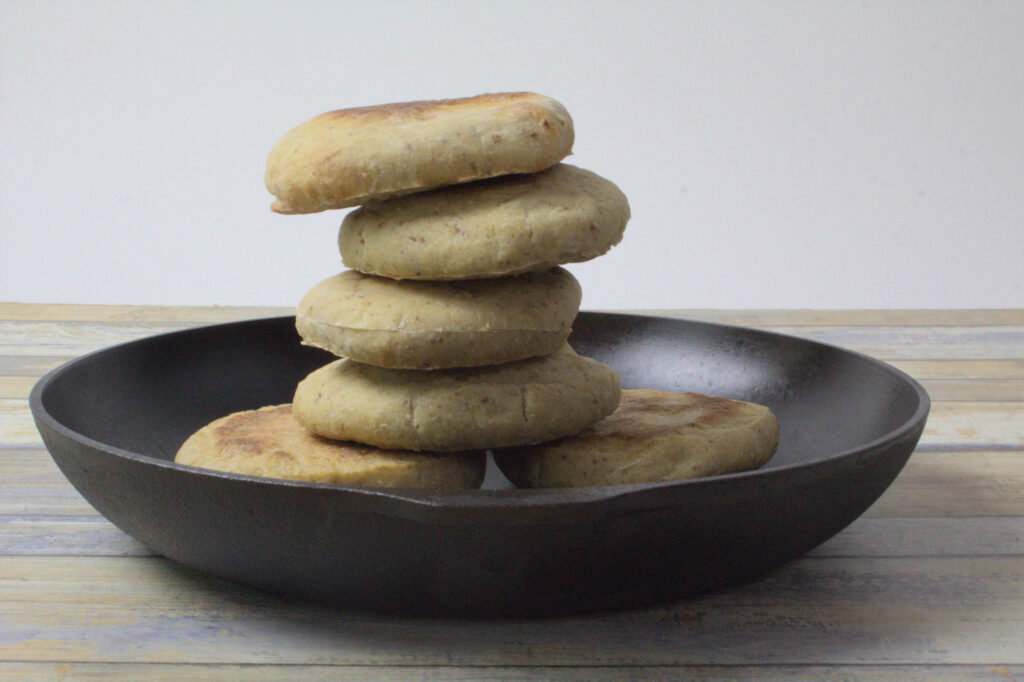
What type of sweet potatoes should you use in this Madeiran Tile Bread?
White or yellow sweet potatoes, which represent the local varieties found in Madeira, are typically used to prepare traditional bolo do caco. These sweet potatoes differ from the orange-fleshed varieties found in other areas of the world.
The sweet potatoes contribute a subtle sweetness and a distinct texture to the bread, complementing its overall flavor profile.
I experimented with white-skinned sweet potatoes and purple-skinned sweet potatoes. I prefer the texture and flavor of the purple-skinned ones.
- Flesh of white-skin sweet potato
- Flesh of purple-skin sweet potato
Roasting the sweet potato for sourdough bolo do caco
Preheat oven to 400 F. Cut the ends off of a sweet potato and place it whole on a baking sheet lined with parchment paper. Bake until tender. This should take about 45 minutes.
When the potatoes are done, they should pierce easily with a knife or fork. Slice the baked sweet potato in half lengthwise and scoop the flesh out into a bowl. Mash well.
After roasting and removing the peels, I ended up with about 200-225 grams of sweet potato for each batch.
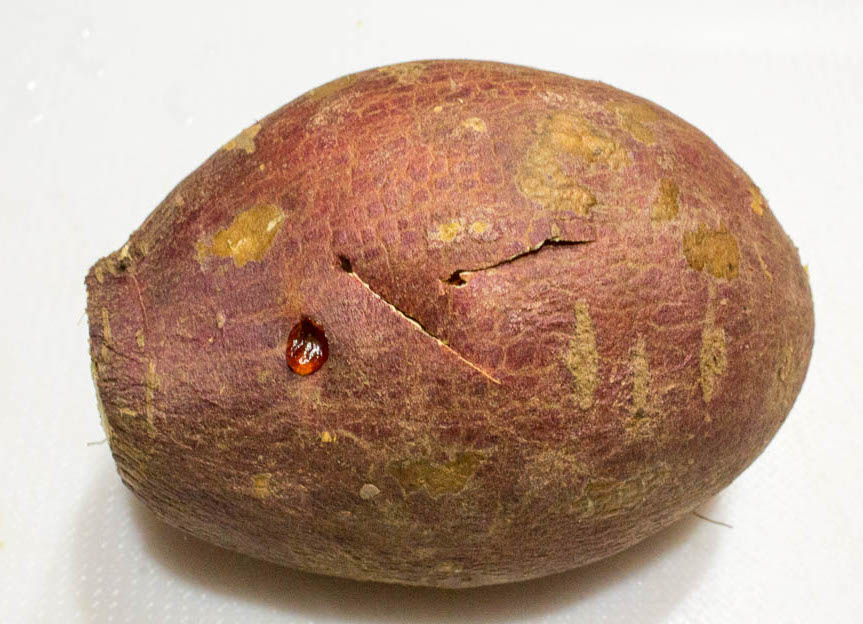
Baking Bolo do Caco on a baking stone vs in a skillet
I tested baking this bread in a cast iron skillet over the stove and on a preheated baking steel in the oven. I baked six breads at a time and kept the rest of the dough in the refrigerator to use the next day.
I had a hard time getting the sourdough bolo do caco to bake all the way through in the skillet. I either had the skillet at too high of a heat or didn’t flatten the breads enough while baking.
My preferred method for making these flat breads is to bake them on a baking stone or baking steel in the oven.
With both methods, skillet and stone, I flipped the breads over and flattened them during baking.
If you bake them in the oven on a baking stone, you definitely need to flatten them partway through baking or they will bloom and end up as crusty rolls. The rolls are delicious, mind you, but a crusty roll is not the look we’re going for here.
Bolo do Caco baked in a skillet:
Bolo do Caco baked on a baking steel
After I had determined my preferred baking method, I decided to look it up on Chatgpt. Here is some info on which baking method best mimics cooking traditional bolo do caco:
“To best mimic the traditional method of cooking bolo do caco on a basalt stone tile, using a baking stone in the oven is more appropriate. A baking stone provides a consistent, evenly distributed heat that closely replicates the conditions of cooking on a basalt stone. It also allows the bread to cook thoroughly and develop a crust similar to what would be achieved with the traditional method.
Cooking the bread in a skillet on the stove is an alternative, especially if a baking stone is not available. This method can still yield a delicious bread with a nice crust, but the heat distribution and cooking environment will differ slightly from using a baking stone. The skillet method might require more attention to prevent the bread from burning and to ensure even cooking on both sides.
Overall, for a closer approximation of the traditional cooking method, go with a baking stone, but a skillet on the stove is a viable option if needed.” OpenAI. (2024). ChatGPT (4) [Large language model]. https://chat.openai.com
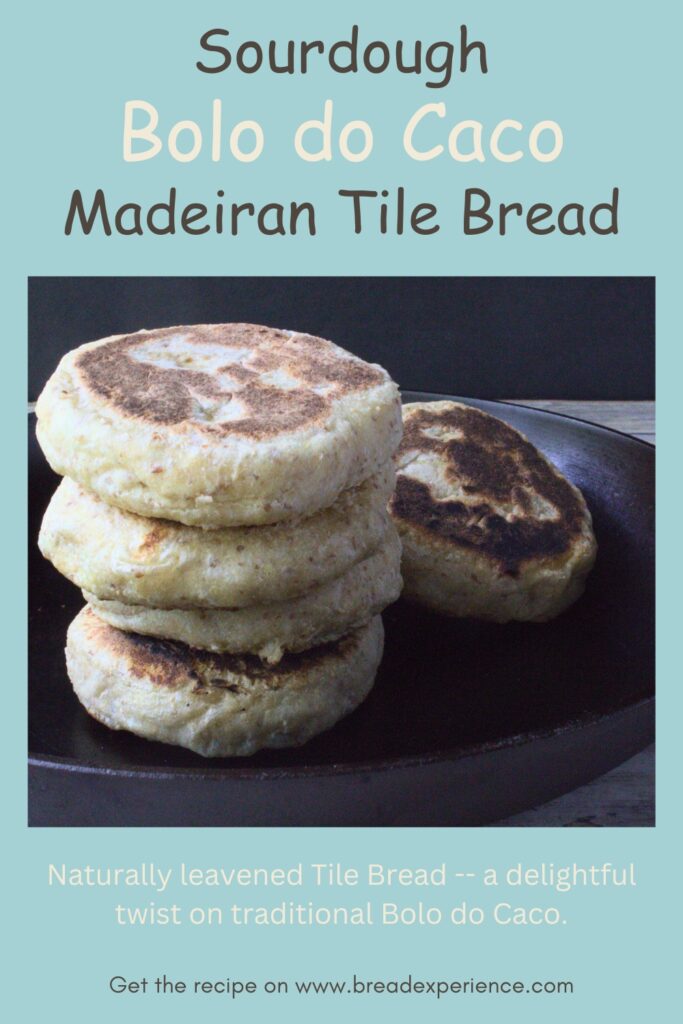
Note: The dough for this sourdough bolo do cao works well when given a cold ferment in the refrigerator overnight, or up to 2 days maybe even 3 days. I made the dough, let it bulk ferment, then placed it in the refrigerator. I baked some of the flatbreads the next day and the rest 48 hours later.
Resources:
- SAVEUR Magazine: Bolo do Caco Recipe
- Karen’s Kitchen Stories: Portuguese-Style Sweet Potato Rolls {Bolo do Caco}
- Cozinha Tradicional: Bolo do Caco (Madeira) [in Portuguese]
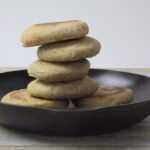
Sourdough Bolo do Caco | Madeiran Tile Bread
- Yield: 12 bolo do caco 1x
Description
This Sourdough Bolo do Caco, also known as Tile Bread, is a delightful twist on the traditional Madeiran bread. It is made with nutritious white sweet potatoes and incorporates a wholesome blend of rye flour and flax meal.
Ingredients
Levain:
40 grams unbleached all-purpose flour
40 grams water
20 grams sourdough starter
Dough:
200–225 grams sweet potato (the kind with white flesh), baked, peeled, and mashed
385 grams unbleached all-purpose flour
50 grams dark rye flour
15 grams flaxseed meal
100 grams sourdough levain, all of the above
130–160 grams body-temperature water, divided
9 grams sea salt
Instructions
Evening Day 1 – Start the Levain
- In a small bowl, combine the sourdough starter, water, and flour. Mix thoroughly to combine.
- Cover and let the mixture rise at warm room temperature until doubled in size, about 8-12 hours, depending on the temperature in your kitchen.
Day 2
Roast Sweet Potato:
- Preheat oven to 400 F. Cut the ends off of a sweet potato and place it whole on a baking sheet lined with parchment paper. Bake until tender. This should take about 45 minutes.
- When the potatoes are done, they should pierce easily with a knife or fork. Slice the baked sweet potato in half lengthwise and scoop the flesh out into a bowl. Mash well. Cool.
Prepare Dough:
- In the bowl of a stand mixer, stir together the flours and flaxseed meal. Add the levain and 100 grams water and mix on low speed to combine. The dough will be a bit dry at this point.
- Add the cooled mashed potato and mix thoroughly, adding additional water, 1 tablespoon at a time, until there are no dry bits of flour. Continue mixing on low speed until the dough comes together and pulls away from the sides of the bowl.
- Cover and let the dough rest on the counter for about 30 minutes before adding the salt.
- Sprinkle the salt over the top of the dough. Mix thoroughly. Add more water, if necessary to form a workable dough. Remove the dough to a clean bowl, cover, and set aside on the counter for 30 minutes more.
- Fold the dough by gently stretching and folding the edges into the center. Cover the bowl and set aside on the counter for 30 minutes more. Repeat the stretch and folds once or twice more, if needed.
- Cover the bowl and set it aside on the counter until the dough has almost doubled. Total bulk proof time will be about 1 ½ – 2 hours, depending on the temperature in your kitchen.
- Cold ferment overnight, if desired
- Continue to shaping and baking the tile breads, or cover the bowl with plastic wrap, and place the dough in the refrigerator to cold ferment overnight, or up to 2 days.
- The next day, allow the dough to warm up to room temperature before shaping and baking the bolo do caco.
Shaping:
- Turn the risen dough out onto a very lightly floured surface. Divide the dough into 12 equal pieces, about 75-80 grams each. Form each piece into a ball. Cover with a clean tea towel and leave on the counter for about 15 minutes.
- Press down on each ball to flatten it into a disc that is approximately 3 cm (~1 inch) thick and one palm in diameter.
Baking the bolo do caco:
- The bread can be baked on a tile (ie: stone) in the oven or on a griddle on the stove top.
- Oven: With the stone on the middle rack of the oven, preheat to 450F. When the oven is hot, place the breads directly on the stone. Bake for 10 to 15 minutes until they are dark gold. Flip and flatten the breads halfway through the baking cycle to ensure even baking. Note: Be careful not to burn yourself when reaching in the oven to flip the flatbreads.
- Stovetop: Heat a griddle, cast iron pan, or taval until very hot. Note that the implement remains dry (there is NO oil). Place each disc on the griddle and cook for 1 to 2 minutes until dark gold on the bottom. Flip the disc over and cook another minute or two.
- Barbecue: Place a pizza stone in the barbecue and pre-heat to hot hot hot. Place the discs on the stone. Close the lid of the barbecue and bake for about 3 minutes. Using blunt-nosed tongs, turn the discs over, close the lid of the barbecue and bake for a further 2 or 3 minutes.
- The bread is done when it has an internal temperature of 200F.
Notes
The dough for this sourdough bolo do cao works well when given a cold ferment in the refrigerator overnight, or up to 2 days maybe even 3 days.
Who are the Bread Baking Babes?
We are a group of bread bakers who get together every other month and bake bread! We would love for you to try this Bolo do Caco and share your experience making it. Elizabeth, of blog from OUR kitchen, is the host kitchen this month. Refer to the instructions on her blog to participate.
New recipes will be posted every other month on the 16th. Look for the next bake in June 2024. Check out our Facebook group to see the participants’ baking results during that time. If you would like to post your results with a Buddy badge on a blog, let us know in the comments or on the Facebook page.
The Bread Baking Babes:
blog from OUR kitchen– Elizabeth (host kitchen)
Bread Experience – Cathy
Karen’s Kitchen Stories – Karen
A Messy Kitchen – Kelly
Judy’s Gross Eats – Judy
My Diverse Kitchen – Aparna
Thyme for Cooking – Katie (roundup)
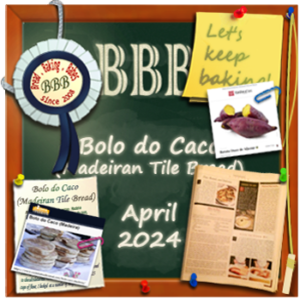
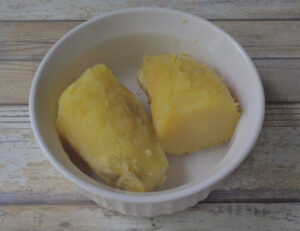
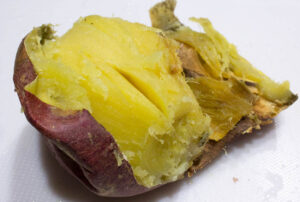
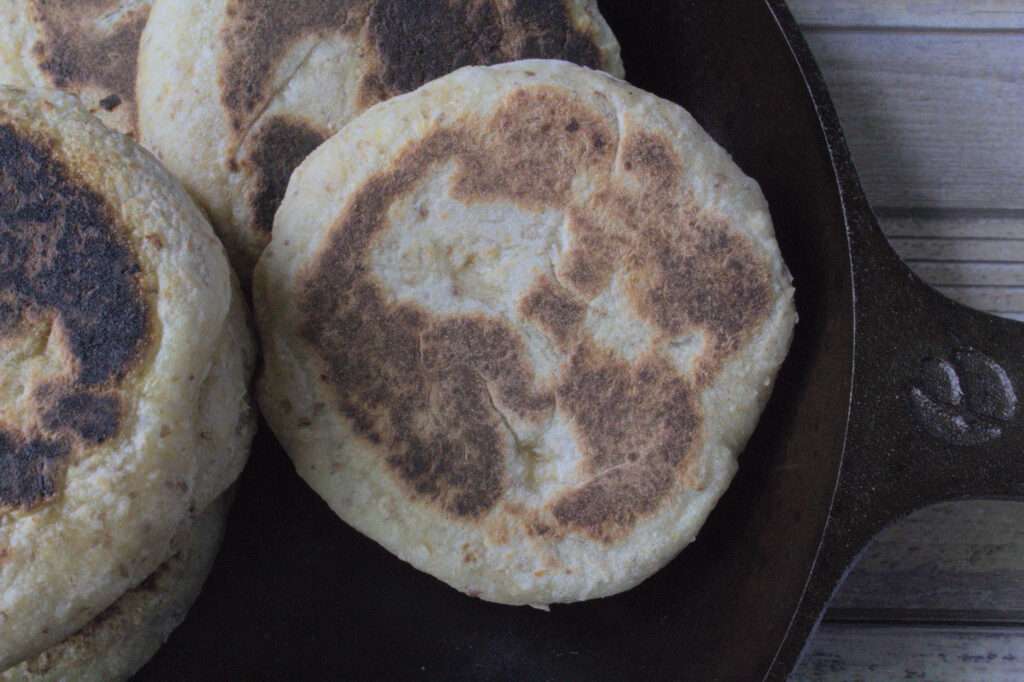
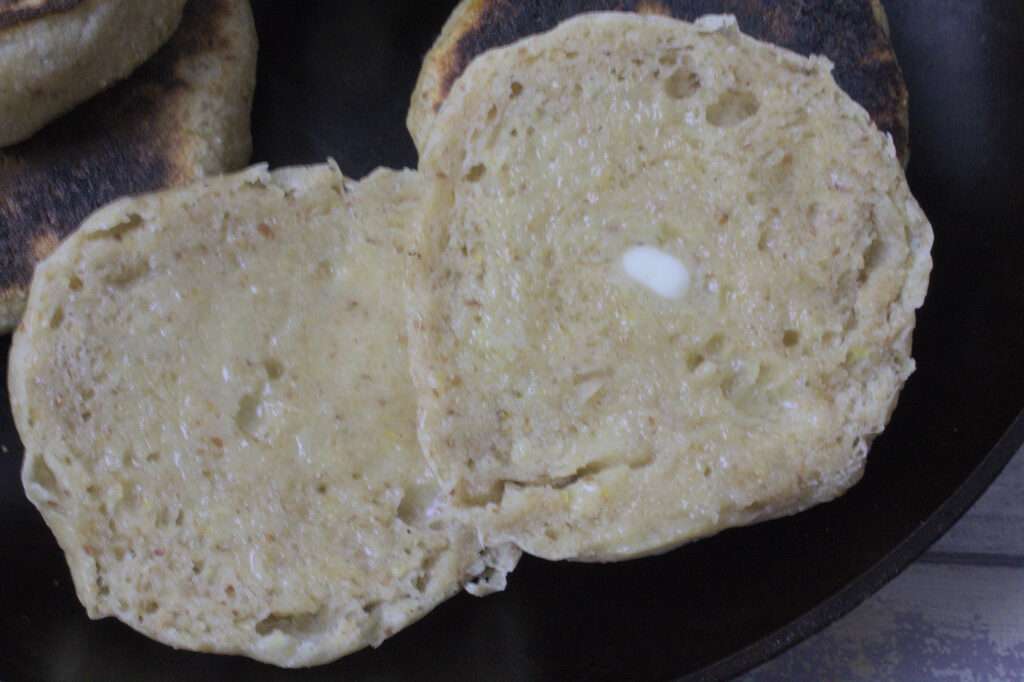
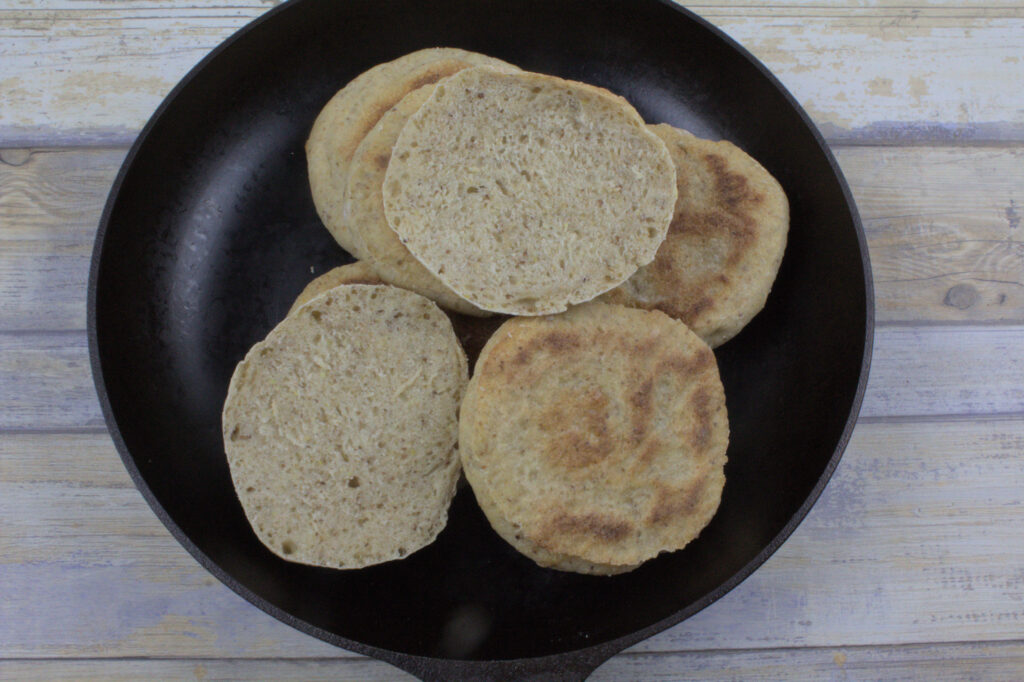
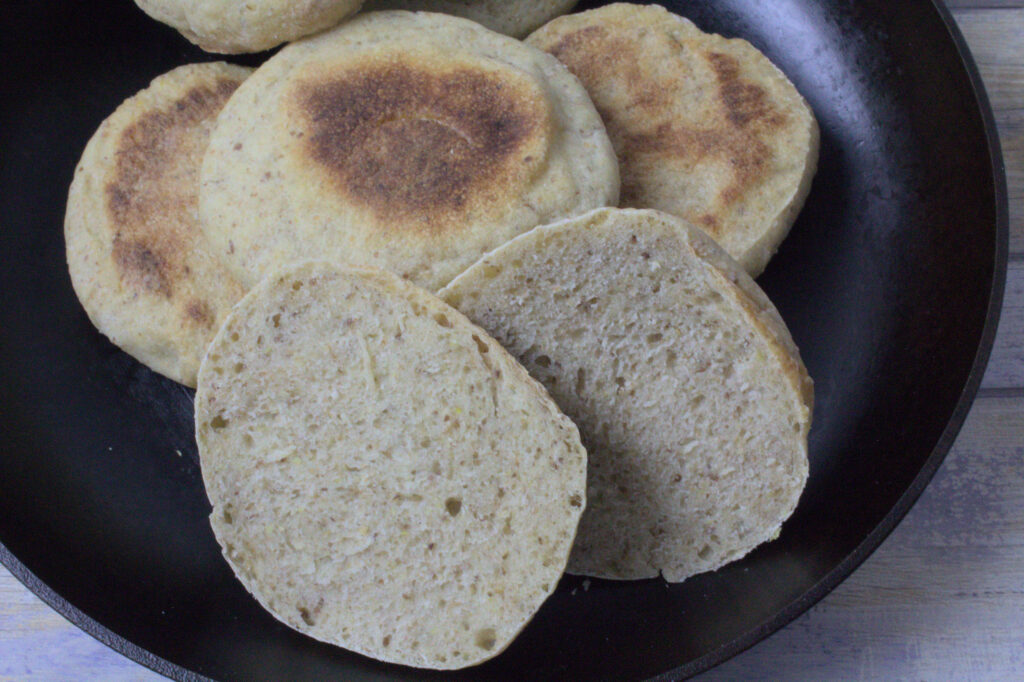
Karen's Kitchen Stories says
Great use of Chat GPT! It’s good to know that the dough will keep well chilled. Both of yours look great!
Cathy says
Thanks! This was a learning experience for sure.
Kelly says
Love the look of the flax and rye! I wish mine had a more even crumb like all of yours but I bumped the yeast because of a different recipe I saw and they really puffed when cooking! Left a craggy interior, much more like an uneven English muffin. Tasty still, but different than all of yours. I did cook on a lower heat to be sure the middles got done and the tiles would start to vent steam if I poked them with the thermometer and they passed the thump test too. Baking in the oven would definitely make that easier.
Cathy says
Baking them in the oven did solve those issues, but I ended up burning myself because I didn’t pull the rack out enough. So there’s that…
Elizabeth says
I’m so glad you used your wild yeast to make these! (I knew we could count on you!) And they look perfect. Yay.
How brilliant that you “flipped the breads over and flattened them during baking”. Otherwise, they turn into buns in the oven. (Not that there’s anything bad about the buns. They just don’t look the same as the Madeiran bread.)
Cathy says
The sourdough version turned out really well even after giving the dough cold ferment. I agree, there is nothing wrong with buns. The first batch I baked on the stone looked like rolls, but they tasted delicious. I decided to flatten them for the next bake. That batch looked more true to form.
Katie Zeller says
Love the sourdough version – esp. the part about leaving it in the fridge…
Cathy says
Indeed! Thanks!